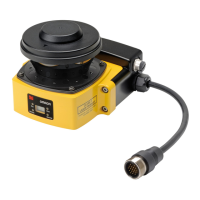97
OS32C
User’s Manual
Chapter4
Installation
E
Configuration for Automated Guided Vehicles (AGV)
Safety Distance (Safety zone depth required for safety zone)
For calculating the minimum safety distance for AGV, the standard IEC 61496-3 can be used. The
safety distance, S, for use with an AGV should be calculated using the following formula:
S = Minimum safety distance in mm measured from the danger area to the outer contour of the safety
zone.
S
p = Maximum stopping distance for AGV (mm)
Z = Additional safety factors (maximum measurement error)
With the conditions above, the minimum safety distance S is calculated as follows:
S = S
p + Z
S
P = (Vmax. x T) + Sbrake
Z = Z1 + Z2 + Zgc + Zbf
Vmax = Maximum speed of AGV in mm/s
T = Response time consisting of sum of t
1, t2 and t3:
t
1 = Response time of OS32C
t
2 = Response time of AGV
t
3 = additional time delay for use when multiple zones are used (t3 = 10 ms.)
S
brake = Braking distance of AGV in mm based on manufacturer's document
Z
1 = OS32C's measurement error (100mm)
Z
2 = Additional error by reflective background (
Additional Error due to Reflective Background
p.131 )
Z
gc
= Safety factor for lack of clearance between under surface of AGV and ground ( Fig. 4-16).
Zbf = Safe factor for reduction of brake force of the AGV through wear and usage.
Fig. 4-16 Safety Factor for Low Ground Clearance
Safety Distance (Width Required for Safety Zone)
Sw = Minimum safety distance of safety zone width (mm)
V
w = Width of AGV (mm)
Z = Additional safety factors (maximum measurement error)
With the conditions above, the minimum safety distance S
w of safety zone width is calculated as
follows:
S
W = VW + 2 x Z

